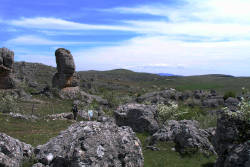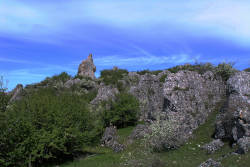Chaos de Nîmes-le-Vieux
Useful Information
| Location: |
L’Hom, 48400 Fraissinet-de-Fourques.
(44.225326, 3.511331) |
| Open: |
no restrictions. [2023] |
| Fee: |
free. [2023] |
| Classification: |
 Limestone Pavements Limestone Pavements
 Stone Forests Stone Forests
 Bare Karst Bare Karst
|
| Light: | n/a |
| Dimension: | A=1,100 m asl. |
| Guided tours: | self guided, L=4.9 km, VR=130 m, D=2 h. |
| Photography: | allowed |
| Accessibility: | no |
| Bibliography: | |
| Address: | Chaos de Nîmes-le-Vieux, L’Hom, 48400 Fraissinet-de-Fourques. |
| As far as we know this information was accurate when it was published (see years in brackets), but may have changed since then. Please check rates and details directly with the companies in question if you need more recent info. |
|
History
| 1908 | discovered by Paul Arnal, pastor at Vebron. |
Description


The Chaos de Nîmes-le-Vieux is a stone forrest and limestone pavement on the Causse Méjean. It is protected by the Cévennes National Park. The trailhead is located at the farm L’Hom. There is a 4 km long trail between Hom and Gally, developed by the Parc National des Cévennes (Cévennes National Park).
The stone forrest was discovered in 1908 by Paul Arnal, pastor at Vebron, who named it in analogy with the Chaos of Montpellier-le-Vieux, which was famous due to the publications by Edouard Alfred Martel 20 years earlier. Martel heard about the discovery and explored it. In 1910, he published an article about the place in the magazine Causses et Cévennes.
«Des hameaux du Veygalier et de l’Hom jusqu’à la Borie de Galy et à la Fontaine d’Aures, il se développe à l’altitude moyenne de 1 100 m sur près de 4 km d’étendue.
C’est un front de falaises, un ressaut de la surface du causse Méjean, qui présente une grande longueur de demi-cirques, tous hérissés de centaines de rocs dolomitiques, troués, taillés, sculptés...»
"From the hamlets of Veygalier and Hom to the Borie de Galy and the Fontaine d’Aures, it develops at an average altitude of 1,100 m over an area of nearly 4 km.
It is a front of cliffs, a projection of the surface of the Méjean causse, which presents a great length of semicircles, all bristling with hundreds of dolomitic rocks, perforated, cut, sculpted..."
Edouard Alfred Martel, 1910, Causses et Cévennes.
 Search DuckDuckGo for "Chaos de Nîmes-le-Vieux"
Search DuckDuckGo for "Chaos de Nîmes-le-Vieux" Google Earth Placemark
Google Earth Placemark Chaos de Nîmes-le-Vieux
Chaos de Nîmes-le-Vieux  - Wikipedia (visited: 08-FEB-2023)
- Wikipedia (visited: 08-FEB-2023) Chaos de Nîmes-Le-Vieux (visited: 08-FEB-2023)
Chaos de Nîmes-Le-Vieux (visited: 08-FEB-2023) Index
Index Topics
Topics Hierarchical
Hierarchical Countries
Countries Maps
Maps